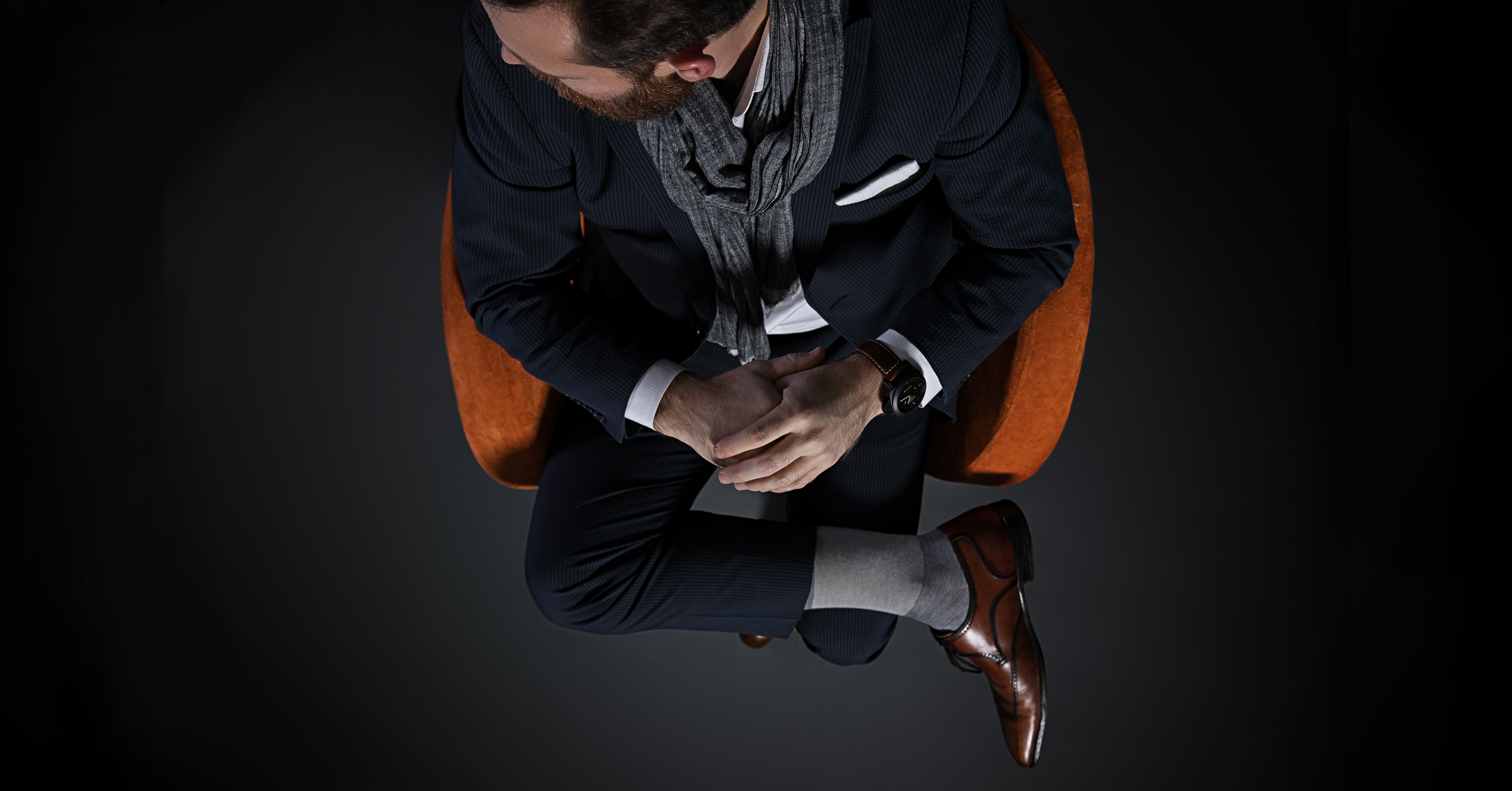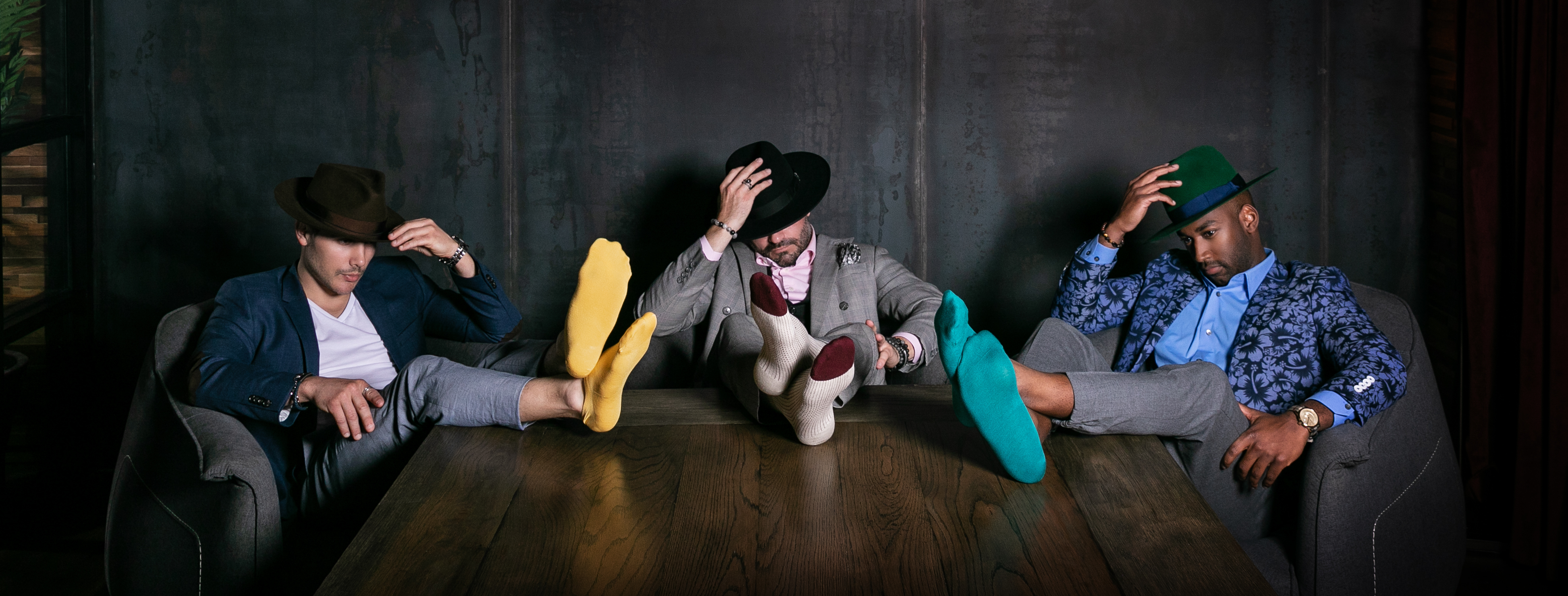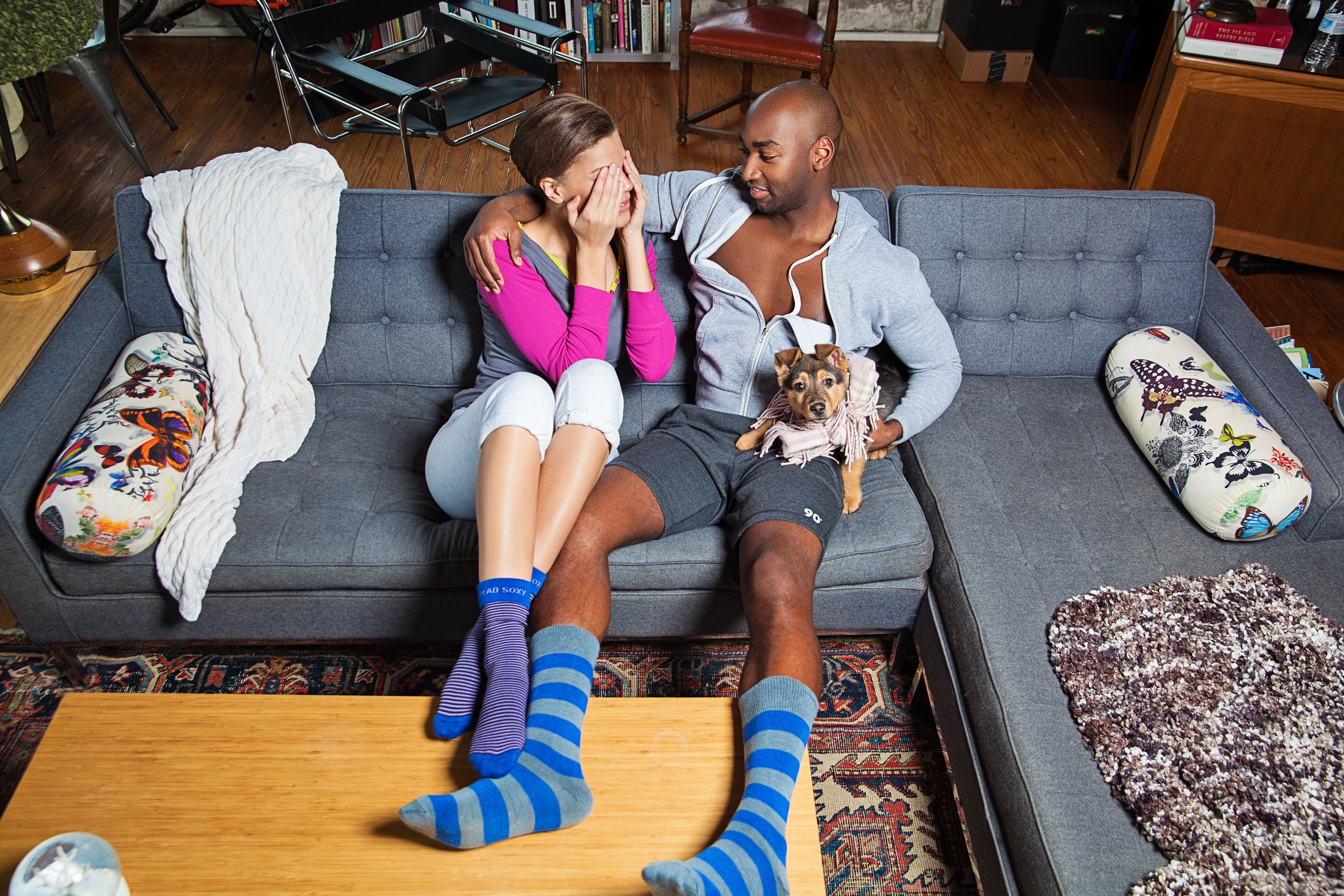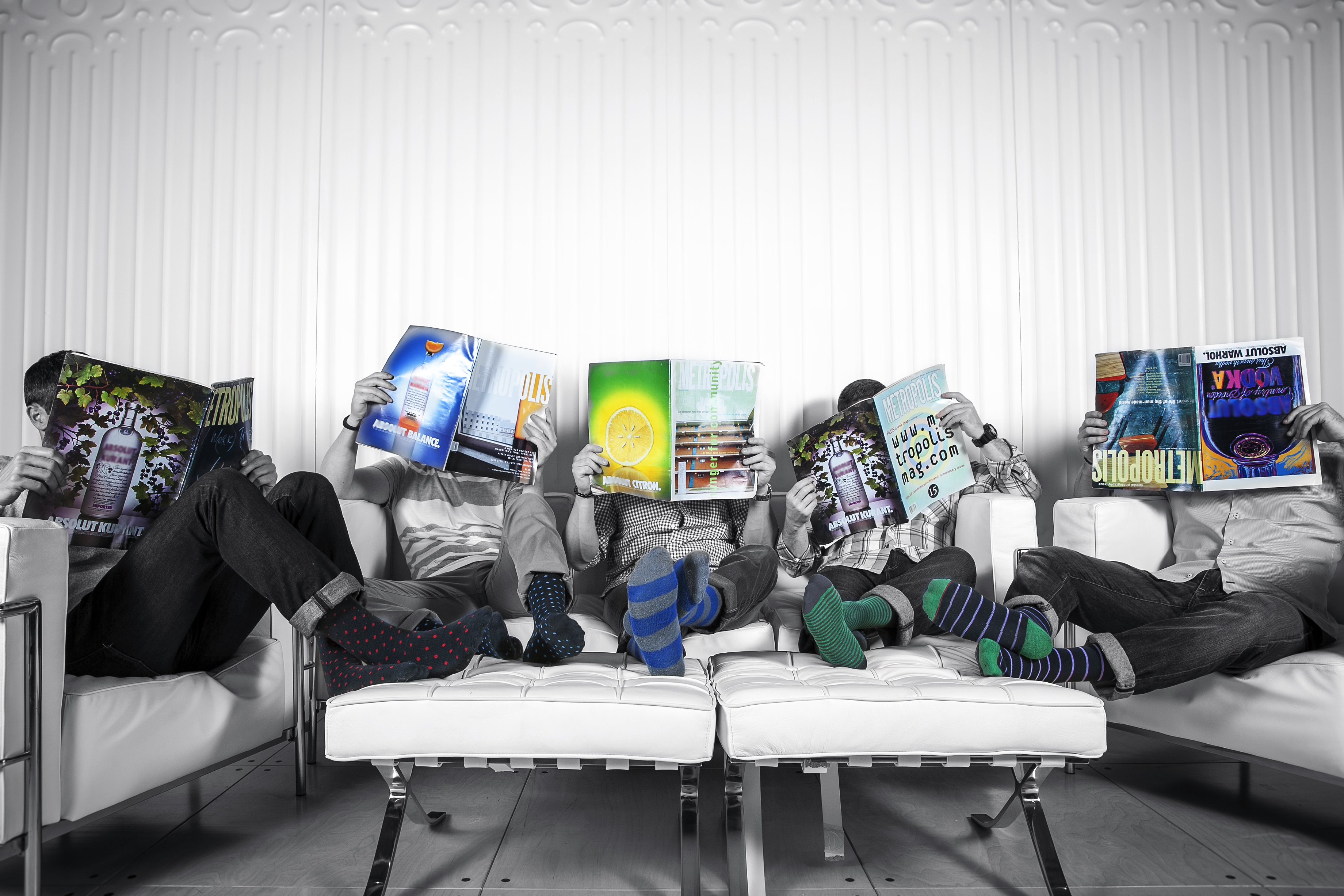The Handsome Man’s Guide To Dress Socks
Sep 06, 2022
The Origin Of Socks - A Brief History
Everything You Need To Know About Dress Socks
- Types
- Men’s Sock Sizes
- Women’s Sock Sizes
- Material
- Color/Pattern
- Care
- What Is The Hallmark Of High-Quality Socks?
- Styling Etiquette For Men’s Dress Socks
- Conclusion
To err is human, but wearing white or short socks with formal suits that expose your ankle is fashion blasphemy. Choosing the right socks that complement your outfit is paramount to looking and feeling your best.
In today’s guide, we explore everything you need to know about men’s dress socks, so you serve your favorite looks seamlessly with maximum comfort. Let us begin by understanding the invention of socks and their journey through time.
The Origin Of Socks - A Brief History

Fun Fact: Socks may very well have been the first invention ever in human history.
Socks made their first appearance in prehistoric times in the form of furry animal skins tied to feet with vines to keep them warm and safe from damage caused by uneven terrain, stickers and rocks. By the 17th century, socks had become a desired item that determined one’s social status and rank. The upper-class opted for silk and cotton socks and the general public resorted to hand-woven socks made with varying fabric.
The invention of knitting machines marked the beginning of socks as an available-to-all accessory. The basic idea behind socks was to keep feet warm and add a layer of protection. It wasn’t long before circular sock knitting machines entered the market, offering a significant quality improvement. Other than the heel and toe areas, the entire sock could be made without seams.
The fundamental transformation began at the dawn of the twentieth century with the introduction of nylon socks which changed the face of men’s dress socks and stockings forever. The number of knitting needles for nylon socks started at 72, resulting in thicker socks. In today’s time, Italian-made Lonati machines are widely known to be the best-in-class for truly luxury socks. Lonati machines have over 200 needles and are responsible for producing the finest socks on the market today from various brands.
Today, Nylon is considered a cheap material that causes sweat despite being more breathable than natural materials such as 100% cotton, wool, cashmere, and silk blends. Today’s advanced craftsmanship, combined with the diverse availability of ultra-soft yarn and game-changing technology that keeps socks in place, such as DeadSoxy’s TrueStay™ technology, allows sock manufacturers to produce the best dress socks.
Everything You Need To Know About Dress Socks

Now that we know about the need for socks and their makeover throughout history, it is time to learn the factors that must be considered when choosing the right dress socks. From the correct shape and size to the material and appearance, we have compiled all the information you need before blessing your feet with a pair of premium dress socks.
It is time to move on from white tennis socks, a staple in men’s wardrobe, and explore the wide range of premium dress socks available in subtle yet unusual colors to elevate every man’s outfit, be it for business, lounging, or an event.
Types
Socks can be categorized into the following categories based on their shape, size, length, and purpose:

Sock Lengths
Socks can be classified by length. The following are the most common categories based on their varying lengths:
-
No-Show Socks / Liner Socks
A sockless look often calls for no-show socks that stay well hidden while keeping your feet comfortable, stylish, and dry. A well-designed pair of no-show socks stay put throughout an active day without slipping off to the back of your heel.
While some fashion experts believe that no-show socks are ideal to be paired with shorts, it isn’t set in stone. When styling no-show socks, the most crucial things are finding a pair that actually stays on your heel and pairing them with the right shoes to avoid blisters on your heel due to shows rubbing against your skin. DeadSoxy No Show Socks are guaranteed to stay on and never cause blisters.
-
No-show Invisible Socks
No-show socks, also known as footie socks, are ideal to be paired with loafers. They are used to line footwear offering an invisible feel.
No-show socks have hit the industry with a storm and can be found in leading fashion publications and magazines. With models donning no-show socks under slip-ons and Oxfords, the only shoes to refrain from no show socks at this point are boots and sandals.
-
Ankle socks
Ankle socks and no-show socks are often confused with one another despite being quite different. No-show socks are designed to sit slightly below the ankle and stay hidden. Ankle socks, on the other hand, sit on or above the ankle to protect your heels and ankles from chafing.
Unlike no-show socks, ankle socks are intended for protection from chafing during physical activities, meaning they aren’t exactly fashion accessories.
-
Quarter-length socks
Quarter-length socks cover your ankles, making them ideal for avoiding blisters. These socks are unisex and go well with work outfits for both men and women. You can pair these socks with trousers, skirts, or shorts, offering a sophisticated and professional look.
-
Crew-length socks
Crew-length socks offer protection from dust and fall between six to eight inches. You can pair crew-length socks with dress shoes for a sophisticated look. These can also be used for outdoor activities such as hiking.
-
Mid-Calf Socks
The most common types of socks that fill up our sock drawers irrespective of one’s age are mid-calf socks. They extend beyond your ankle and sit right below the most significant part of your calf. Mid-calf socks are versatile and ideal for pairing with any footwear, from sneakers and loafers to dress shoes, boots, and everything in between.
Their popularity is due to their versatility which means they can be found in any color, pattern, thickness, and material of your choice. Mid-calf socks have an athletic version dedicated to being worn during physical activities.
-
Over-the-Calf (OTC) Socks or Knee length Socks
Over-the-Calf socks used to be the only reliable means to keep socks from falling and pooling around your ankles. However, with sock manufacturing processes being transformed in the current times, this knee-high style has taken a severe hit in its popularity.
OTC socks offer a high-end fashion look, especially when worn by women and paired with boots. Over-the-Calf socks are ideal to ensure that your socks stay in place. Additionally, OTC socks provide complete protection in harsh weather conditions.
Styling Tip!
Sock etiquettes dictate that formal attires traditionally call for long/dress socks to prevent skin flashing due to their ability to stay in place.
Size

When buying socks, it is essential to remember that different sock sizes, such as US/European/UK sizes, differ based on your foot length and not on your shoe size. We recommend going 1 or 2 sizes larger than your shoe size to find your ideal sock size. A well-fitted sock should hug your feet without leaving pressure points and offer optimum relaxation.
Men’s Sock Sizes
When buying socks for men, note what the label reads. Standard men’s socks fall between “US size 10-13” and are sold under this label. Measure your foot length and pick the corresponding sock size. The “US 10-13 size” corresponds to the US shoe size of 8-12.5.
Women’s Sock Sizes
Traditionally women’s socks are sold under the label “US size 9-11,” which corresponds to the European shoe size of 36-41 and US shoe size of 5-10. For those with shoe sizes above US 10, getting men’s socks of size 10-13 or custom-made socks can be ideal. Using a measuring tape is a great tip to measure your foot length.
No, you cannot “make it work” if you get a smaller or larger size. Smaller socks would end up suffocating your feet, whereas more giant socks would have excess material, causing them to fall out of place.
When choosing the perfect sock fit for you, we recommend taking those extra 0.5 seconds to double-check the size of the socks before finalizing the purchase.
For a selection of socks in different sizes for men and women, click here.
-
Purpose
Socks can be categorized into the following categories based on the purpose they serve:
1. Dress socks:
Dress socks offer a tailored, handsome look when paired with a suit or casual clothes. They are available in a variety of colors and patterns. When working with dress socks, it is advisable to stick to darker colors such as black, charcoal grey, medium grey, bottle green, brown, and burgundy, and match your socks with your trousers. You can experiment with lighter colors such as tan with more delicate clothing.
2. Hiking socks:
Hiking socks are made to withstand extreme weather and dramatically varying temperatures. Designed to facilitate seamless hiking and other outdoor activities, hiking socks are perfect due to their heavy-duty nature. Moisture-wicking wool socks are great for hiking.
3. Athletic Performance Socks:
Athletic performance socks are worn to compliment a man’s physical performance. From the basic cotton tube sock to no-show socks with moisture-wicking properties and insulation, athletic performance socks are designed to maximize comfort, especially during athletic adventures. Athletic socks keep your feet in place and prevent sliding in your shoes, blisters, and foul odor.
4. Protective Socks:
Protective socks are designed using heavier weaves and higher concentrations of insulating fibers. These are meant to be worn in icy conditions where changing socks frequently can be challenging. While loading up on insulating fibers may lead to a slight compromise on fit, it maximizes performance and protection under extreme conditions.
Material

-
Wool
Wool socks are itchy; however, that is only the case with coarse fiber found in vintage, hand-me-downs with heirloom or cheap wool. Wool offers excellent moisture-wicking properties, temperature control, and durability.
Select dress socks made from fine/ultrafine wool that blends easily with other materials. Wool offers excellent insulation and protects your feet. It can hold a third of its weight in moisture before feeling wet.
-
Cotton
Cotton socks may not be the right fit for you if you suffer from sweaty and hot feet due to their moisture-absorbing properties. Cotton is less durable and tends to be less springy once compressed than wool. Cheap cotton socks are often poorly shaped and haphazardly stitched, which leads to a common opinion that cotton isn’t ideal for socks.
However, being the most common material for men’s dress socks, cotton is affordable, comfortable, and durable when combined with other materials. Cotton offers unparalleled breathability to your dress socks which is excellent for your feet.
Cotton is best when combined with other materials that enhance its elasticity, durability, etc. Common materials used in blends include acrylic, cotton, linen, nylon, polyester, rayon, silk, spandex(lycra), and wool.
-
Natural Fibers
Natural fibers are more expensive than synthetic fibers due to their high moisture absorbing properties, lowering your tendency to sweat in them. Great sock manufacturers offer the softest socks made from Bamboo yarn that maintain their shape and stay in place and are also environmentally friendly. In addition to cotton, cashmere or wool is equally suitable for superior quality yarn.
-
Silk
Silk socks are the most expensive men’s dress socks and are for fashion purposes only since they don’t last as long as other materials. Pair silk socks for black-tie and formal events with your suits.
-
Cashmere
Cashmere socks deliver a combination of luxury and warmth. However, remember that cashmere socks must be hand washed and shouldn’t be put in the dryer.
Color/Pattern

We suggest matching your pant color or going a shade darker that offers a natural look by being shadow-like and extending your leg, making you appear taller. Be mindful not to match your sock color/pattern with your shoe since it might appear as a deformed boot.
Solid colors like dark grey, blue, and brown socks are ideal for denim or navy pants. Dark brown, grey, and blue socks pair great with khaki pants. Thin black socks are always a great option when pairing your black or dark-grey pants with socks.
If you want to experiment with your attire, we suggest you opt for solid-colored dress socks with minimal patterns that complement and do not clash with the color of your pants.
Care
The longevity of your socks depends on how well you look after them. For best care and longer life, hand wash socks and hang them dry. Check the label before buying socks to identify the washing recommendations; most fall under the Machine-wash warm, Tumble-dry medium category. You can store your socks by folding, rolling, or rolling. Once damage occurs, it is advisable to discard the socks or repurpose them as rags, polishers, or dusters.
What Is The Hallmark Of High-Quality Socks?
Now that we have acquainted ourselves with the types of socks based on length, size, and purpose, it is time to learn how to identify the best-quality socks. Buying a pair of high-quality socks is an investment because it protects your feet against blisters and shoes from damage and is built to last a long time. High-quality socks can help you save serious cash eliminating the need to buy new socks regularly.
When looking for a new pair of socks, here are the considerations to keep in mind:
1. Moisture-wicking:
Moisture-wicking socks push moisture away from your foot to the surface of the socks allowing your feet to breathe while reducing friction.
2. Snug fit and padded:
Socks that fit snugly are the right choice for you. Snug-fit socks prevent socks from bunching together, sliding down, and looking bulky. Padding reduces the impact of your foot hitting the ground, preventing blisters.
3. Uses Natural materials:
Socks made from natural materials ensure longevity. Wool, cotton, and bamboo are the most popular raw materials.
Styling Etiquette For Men’s Dress Socks

Of course, when it comes to fashion, the rules are a little blurry when it comes to style, but the basics of styling dress socks can help you navigate the waters seamlessly.
1. Dress For The Occasion
You should steer clear of bold and bright patterns for black or white tie events. Occasion-specific socks like the Groomsmen dress socks are knitted on machines with over 200 needles with the softest yarn offering utmost elegance.
The key to properly utilizing dress socks is to pick them for the right occasion - athletic socks are for active wear only; for events, wear over-the-calf dress socks.
2. Say Yes To Thin Dress Socks
Thick cushy socks are acceptable for athleisure purposes; when pairing your suit with your socks, refrain from bulky socks. Thin dress socks look much smarter when paired with a formal suit for an event.
3. Match Socks With Your Outfit
It is always advisable to choose socks based on the color of your trousers. When choosing striped or multi-colored socks, you can incorporate the same colored accessory in your attire - a tie, bow tie, shoelaces, or even a pocket square goes a long way. Irrespective of how you match your socks with your dress, having some form of coordination makes you look well groomed.
4. Don’t Mix-And-Match Them
Socks come as a pair and aren’t intended to be mixed and matched. Pair your socks carefully; wearing different hues of the same color can go wrong, which is why you should be extra careful to keep your socks paired correctly.
5. Fret Not & Go Dark
Choosing the right color for your dress socks can be tricky, so darker colors such as black, brown, or navy are always a safe option. These traditional colors keep you under the radar, especially when trying not to stand out.
6. Add Texture or Ribbing
Wearing conventional socks doesn’t mean you are left with no options for experimentation. Experimenting with texture by opting for ribbed socks is the easiest way to upgrade your socks. The seams in ribbed socks add subtle visual interest and can be worn in any color imaginable.
7. Wear No-Shows with Caution
Flashing your ankles in any formal environment is frowned upon. No-show socks may dent your fashion reputation, especially when attending a conservative event. Try to avoid pairing no-show socks with formal suits.
8. Solid Colors Elevate Your Style
Experiment with solid or color-blocked dress socks to showcase your impeccable taste and fashion know-how to your look. Bold-colored socks are the easiest way to accentuate your look and incorporate thoughtful accessorizing.
9. Stripes, Dots & Argyle
If you wish to take your look to the next level without going all out of experimentation, incorporating stripes, polka dots, or argyle is the next bet after solid colors. These three dress sock patterns are classic and timeless, making them easy for you to match with your outfit.
Click here to select a diverse range of dress sock patterns and colors.
10. Match Your Socks With Overall Aesthetic
A great rule of thumb when pairing your socks with your outfit is to mirror the color of your dress socks with another color from your outfit that is visible above your waistline. Maintaining color continuity throughout your outfit brings the entire look together.
11. Don’t Match Patterns
While matching the color of your dress socks with your outfit is recommended, avoid matching the pattern of your socks with a design that exists in your look. Matching patterns on patterns can look like you are trying too hard and may ruin your look. So, avoid wearing dotted socks with polka dot shirts in the future.
12. Bold is Better
Novelty socks aren’t everyone’s thing and can be a challenge. However, utilizing a little fashion know-how with confidence can make it the most fun thing to do when experimenting with dress socks. We have our heart set on DeadSoxy’s new line of socks that combine wearability and comfort seamlessly.
13. Show Off Your Dress Socks
You could choose your socks based on your outfit, OR you could build an outfit that displays your socks as the star. Try pairing novelty socks with toned-down outfits to make them appear more striking in comparison.
14. Keep Your Sock Drawer Organized
The organization is vital when putting together an outfit. A well-organized sock drawer makes it easier to find the right socks for your outfit. Folding and stacking them in a horizontal row allows you to make better sock choices.
Conclusion
Navigating the world of men’s dress socks can be challenging, especially if you pick one that isn’t sized correctly and ends up sliding down your calf, flashing your skin. Investing in premium dress socks that are sized for your foot and height guarantees maximum comfort all day long.
DeadSoxy’s patented TrueStay™ technology ensures your dress socks stay in place, exactly where you need them. We offer the best dress socks for men that includes a flat toe seam (seamless), arch support to prevent the foot from sliding inside the sock, and a deeper heel contour for a snug fit. Get in touch with us today to explore the world of premium dress socks.
Check out DeadSoxy’s Men’s socks collection here.
Suggested Products:
Follow DeadSoxy on Instagram to check out their products and stay updated on their developments and new releases.
CONTACT:
Company: DeadSoxy
Email:
j.simmons@deadsoxy.com
Phone: 972-861-0103
Website: www.deadsoxy.com



